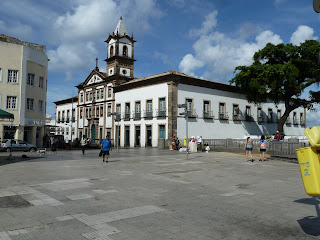Prepared January 28 and 30, 2012 South Atlantic Ocean, en route to Jamestown, St. Helena and Walvis Bay, Namibia
In Port and at Sea, January 23, 2012 Rio de Janeiro, Guanabara Bay, and South Atlantic Ocean: Finding a Cobbler in Copacabana
Sleeping late to recover from the previous day's urban safari, we fought our way through the masses dissembarking and wandering around lost from another Costa VLHC (VLHC -- Very Large Human Carrier as compared to a VLCC -- Very Large Crude Carrier). Then, walking quickly and looking straight ahead, we pass through the gauntlet of jewelry salesmen and finally reach the 60-passenger shuttle bus for the one-hour trip from the cruise terminal to the Copacabana section of Rio de Janeiro.
J & E are on a mission. E's dress shoes had lost their heel caps when she wore them to a formal-night cocktail party and dinner. So, the heel caps must be replaced at all costs -- including a one-hour bus ride in Rio's Monday morning traffic! Before we left the ship, we had been given directions by the local on-board travel consultant. She had telephoned and talked and finally come up with two approximate addresses somewhere in the Copacabana district for cobblers. The street names and directions were, however, a little vague, or possibly failed to make the transition from Portuguese to English. Thus, the Monday morning Silversea shuttle bus trip to Copacabana at about 10:00a.
The shuttle bus dropped us in front of the Othon Palace Hotel on Atlantic Avenue across from Copacabana Beach. Speaking with the bellman, it was determined that there was a shoe repair shop about five blocks away on D. Ferreira Street -- well within walking distance. So, off we went to the shoe repair shop, which we found with no trouble. The cobbler was present, and after an interesting, multicultural show-and-tell, the nature of the repair was established (new heel caps), the price (~US$ 15.00), and the time (about two hours). This took some effort because the cobbler was Italian, speaking only Italian and Portuguese, and we spoke neither. But, with the help of the cobbler's friend, who thought he spoke some English, all was arranged. It also helped that the shoes in question were Italian made (Ferragamo), and national honor was involved in their repair.
Since we had to wait for the shoes, we decided to walk along Atlantic Avenue (opposite Copacabana Beach) to the Copacabana Palace Hotel for a coffee and some treats. This was a longer walk than we had anticipated in the hot mid-day sun. J and E will never learn! But, the hotel was cool and a good place to wait, over a cappuccino, fruit and breakfast rolls. The only glitch was that we arrived at the time of a staff changeover, so it took awhile to get waited on and served. If you want it fast, go to McDonald's!
Copacabana Palace from Atlantic Avenue
To stay in the shade, we walked back along the interior streets and looked at the shops. Sadly, from the point of the Brazilian economy, nothing was purchased. Arriving at the shoe repair shop, the shoes were ready. After inspection and E's declaration that all was correct and in order, the shoes were wrapped in a plastic bag and placed in a book bag for transport back to the ship.
Atlantic Avenue's Wave Design Sidewalk Paving
The next Silversea shuttle bus was not to arrive for about an hour, so we sat in the Othon Palace Hotel's side lobby until it came. The return bus trip to the Cruise Terminal was only 20 minutes. On arriving at the terminal, we experienced another example of mass tourism run amok. But, with the assistance of the ship's crew, we successfully boarded the Silver Whisper in time for our 6:00pm departure from Rio de Janeiro.
We had been moored next to the Brazilian naval piers in Cais do Porto, and on departure, J got to see an old acquaintance: the Brazilian navy's aircraft carrier (BNS Minas Gerias). The Minas Gerias had been anchored off Rio, along with the USS Yorktown, when the Yorktown made a port visit to Rio de Janeiro in 1969 at Carnival. Hopefully, the Minas Gerias, like the Yorktown, is now a naval museum!
BNS Minas Gerais
Brazil's Naval Academy
On the track down Guanabara Bay to the Altantic, we again saw the Petrobas oil production fleet with oil rigs and drilling ships. After passing through the mouth of the Bay, we entered the Atlantic and set course for St. Helena Island, a five-day cruise to the east northeast.
Goodbye Rio de Janeiro!


























































